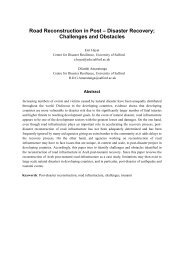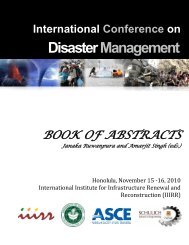Alternative resilient livelihood option for fisher-folks tsunami victims
Alternative resilient livelihood option for fisher-folks tsunami victims
Alternative resilient livelihood option for fisher-folks tsunami victims
Create successful ePaper yourself
Turn your PDF publications into a flip-book with our unique Google optimized e-Paper software.
Cage 5 17.14 12,855.00<br />
58,762.50<br />
For five cages 24,312.50<br />
For one cage 4,862.50<br />
After 6-7 month of culture fish reach 500-600 gms each. Also nearly 15 kg fish can be harvested<br />
from each cage which was sold at 750/= per kilo. Cages and fries were supplied by CIDA there<strong>for</strong>e<br />
no expenditure <strong>for</strong> <strong>fisher</strong> <strong>folks</strong>. At off season though the harvests lessen the dried fish fetch a high<br />
price in the market thus the economic trend remains same. In Sri Lanka most lagoons are short and<br />
seasonal and do not support sustainable <strong>fisher</strong>ies. The best way of overcome this resistance to this<br />
innovation is to introduce Milk fish farming gradually, while ensuring that the methods employed<br />
were those most certain to achieve positive economic results. If more fish can thus be made<br />
available <strong>for</strong> food, and additional income can be derived too. There are abundant shrimp ponds in<br />
the coastal belt of Batticaloa. These ponds also can be utilized <strong>for</strong> milk fish farming in a productive<br />
manner with least cost and also prawn farms or swamps and marshlands can be developed into<br />
brackish water productive milkfish ponds. It was characteristic of milkfish that given unfavorable<br />
living conditions such as crowding, insufficient food, low water temperature, or low pH, etc., their<br />
growth would be slow or non-existent. However, when given good living conditions, the fish would<br />
grow faster than their normal growth rate even after having been subjected to those previous<br />
unfavourable conditions. This process is called “stunting” (Castanos, 1995).<br />
Biodiversity was impacted in several ways by illegal fishing practices including used undersize<br />
mesh net, dynamite fishing, light fishing while shrimp farming practices including destruction of<br />
mangrove swamps and pollution of natural water bodies and also our farming site was one of the<br />
most environmentally stressed coastal area of the Batticaloa district by both the Tsunami disaster of<br />
December 2004 and the destruction of ecologically sensitive (Mangroves) area due to unplanned<br />
developmental activities following Tsunami (Santharooban and Vinobaba, 2007). These activities<br />
severely impact on milk fish. Above mention activity will pave the path to the loss of important<br />
spawning and nursery grounds of milk fish and affects local <strong>fisher</strong>ies resulting in reduced yields <strong>for</strong><br />
local <strong>fisher</strong>men. On the other hand destruction of mangroves negatively impacts the milk fish<br />
population because of them spend a portion of their lifecycle in mangrove <strong>for</strong>ests.<br />
3.1 Conclusion<br />
This is an environment friendly alternative <strong>resilient</strong> <strong>livelihood</strong> <strong>option</strong> with reasonable income.<br />
Initial results were promising the farming will take up on a commercial scale.

















